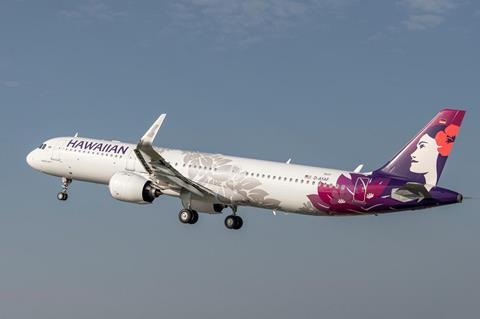Hawaiian Airlines and Alaska Airlines have released more information about their potential merger, including reciprocal break-up fees in the case of non-consummation of the proposed transaction.
The carriers said on 3 December they entered into a $1 billion all-cash deal that will see Alaska acquire Hawaiian for $18 per share and assume $900 million of its debt, while maintaining the two separate brands. Executives expect the acquisition will close sometime in 2025, pending Hawaiian’s shareholder and US aviation regulator approvals.
According to a filing with the US Securities and Exchange Commission (SEC) on 4 December, if Hawaiian terminates the agreement it will be required to pay Alaska $39.6 million.
While Hawaiian’s board approved the deal over the weekend, its shareholders are expected to vote on it in early 2024. If they reject it, that fee will be “up to $25 million in reasonable and documented out-of-pocket costs and expenses incurred by Alaska in connection with the transactions”, the companies say.
But if Alaska terminates the planned acquisition, it will pay Hawaiian $100 million.
The deal can be terminated if it has not been completed ”on or before June 2, 2025, which may be extended to December 2, 2025 in certain circumstances”, the SEC filing says.

Alaska chief executive Ben Minicucci is to be CEO of the combined company, which will be headquartered in Seattle.
Alaska operates a US West Coast-heavy route network, while Hawaiian’s network includes intra-island Hawaii flights and long-haul flights to the mainland USA, South Pacific, Australia and Asia. The combination will allow Honolulu-headquartered Hawaiian to join the OneWorld alliance, of which Alaska is a member. The carriers said Honolulu will become a second hub for Alaska, enabling it to benefit from seamless transpacific connections.
Together, the airlines will fly to 138 destinations, with nonstop flights to 29 international destinations in the Americas and Asia-Pacific region, they said.
ANALYST REACTION
In initial assessments of the surprise Sunday morning announcement, aviation analysts largely agree the transaction would benefit both companies.
“This transaction makes good common sense for both airlines,” writes TD Cowen analyst Helane Becker. “For Alaska, it enables international growth in the Asia-Pacific region which is one of the faster growing markets in the world. For Hawaiian, it enables their passengers to fly to more places on the US mainland on a nonstop or one-stop basis versus multiple stops now.”
Analysts at Deutsche Bank write, “One can’t lose sight of the fact that Hawaiian is currently burning cash and has yet to return to profitability, unlike many of its peers. So Alaska management will not only be executing a merger, but a turnaround as well.”
But regulatory approval issues remain a concern, especially since another airline combination – JetBlue Airways’ planned $3.8 billion takeover of Spirit Airlines – is currently the subject of an antitrust trial in Boston. The US Department of Justice sued those carriers to block the deal, alleging the acquisition would reduce competition, violating antitrust law.
Citi analyst Stephen Trent is taking a “wait-and-see approach”.
“On one hand, the proposed valuation looks relatively modest: Hawaiian’s fleet of [Airbus] A330 widebodies could provide Alaska with better opportunities to capitalise on its OneWorld alliance global membership and expected synergies appear to be significant,” he says. “On the other, there could be potential regulatory resistance to this proposal – even though the two carriers appear to have less overlap than other merger candidates.”
Alaska and Hawaiian carried a combined 54.7 million passengers during the first eight months of 2023. They say both brands will remain independent but that the airlines will be integrated ”into a single operating platform”.


























